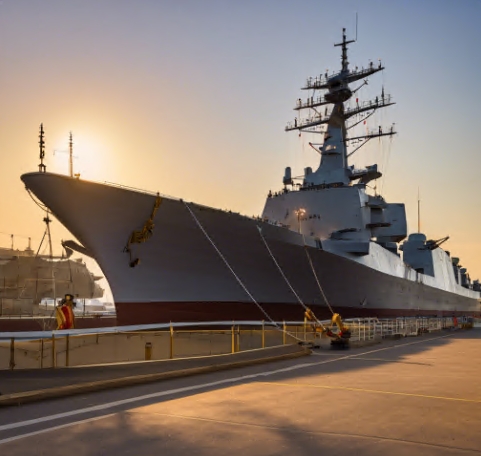BLOG
How Much Does It Cost to Build a Naval Shipyard?
Building a naval shipyard is a significant investment that requires careful planning, substantial capital, and an understanding of the various factors involved in the construction and operation of such facilities. In this article, we will explore the costs associated with building a naval shipyard, the various factors that influence these costs, and the potential returns on investment.

What is a Naval Shipyard?
Definition and Purpose
A naval shipyard is a facility designed for the construction, repair, and maintenance of naval ships, including military vessels such as destroyers, submarines, and support ships. These shipyards are critical to maintaining a nation’s naval capabilities and ensuring that fleets are ready for deployment.
Types of Naval Shipyards
- Public Shipyards: Operated by the government, these facilities often serve the national military and are funded through public budgets.
- Private Shipyards: Operated by private companies, these facilities often engage in commercial shipbuilding and repair, serving both military and civilian markets.
Factors Influencing the Cost of Building a Naval Shipyard
1. Location
The location of the shipyard significantly affects the overall costs. Key considerations include:
- Proximity to water bodies for easy access to ship launching and repair.
- Availability of land and its cost.
- Local labor market conditions and availability of skilled workers.
2. Design and Infrastructure
The design of the shipyard will dictate the types of ships that can be constructed or repaired. Important infrastructure includes:
- Dry Docks: Essential for the construction and repair of large vessels.
- Slipways: Used for launching ships.
- Workshops and Assembly Areas: Where construction and maintenance take place.
- Office Buildings: For administrative functions.
3. Equipment and Technology
Investing in advanced technology and equipment is crucial for modern shipyards. Costs will include:
- Crane Systems: For lifting heavy materials and equipment.
- Machinery: Such as cutting, welding, and assembly tools.
- Software: For design and project management.
4. Labor Costs
Labor is one of the most significant ongoing expenses. Costs will vary based on:
- The local wage rates for skilled and unskilled labor.
- The need for specialized training programs for workers.
5. Regulatory Compliance
Shipyards must comply with various regulations, including environmental and safety standards, which can add to the costs. This includes:
- Environmental impact assessments.
- Safety certifications.
- Compliance with international shipping standards.
6. Financing and Budgeting
The cost of financing the construction will affect the overall budget. Considerations include:
- Interest rates on loans.
- Terms of repayment.
- Potential government grants or incentives.
Estimated Costs to Build a Naval Shipyard
Initial Investment Costs
The total cost to build a naval shipyard can range significantly based on the factors mentioned above. Here is a rough breakdown:
| Item | Estimated Cost |
|---|---|
| Land Acquisition | $1 million – $10 million |
| Design and Planning | $500,000 – $2 million |
| Construction of Infrastructure | $10 million – $100 million |
| Equipment and Technology | $5 million – $30 million |
| Initial Labor Costs | $2 million – $10 million |
| Regulatory Compliance | $500,000 – $3 million |
| Total Estimated Cost | $19 million – $155 million |
Ongoing Operational Costs
In addition to the initial investment, ongoing operational costs must also be considered, including:
- Labor salaries.
- Maintenance of equipment and facilities.
- Utility costs (electricity, water, etc.).
- Administrative expenses.
Potential Returns on Investment
Building a naval shipyard can be financially rewarding, especially if the facility is strategically located and well-managed. Here are some factors to consider when assessing the potential ROI:
1. Government Contracts
Public shipyards often secure contracts with the government for the construction and maintenance of naval vessels. This can provide a stable revenue stream.
2. Commercial Opportunities
Private shipyards can also engage in commercial shipbuilding and repairs, diversifying their income sources.
3. Technological Advancements
Investing in advanced technology can improve efficiency and reduce costs, increasing profitability.
Common FAQs About Building a Naval Shipyard
1. How long does it take to build a naval shipyard?
The timeline for constructing a naval shipyard can vary but typically ranges from 2 to 5 years, depending on the complexity and scale of the facility.
2. What types of ships can be built in a naval shipyard?
Naval shipyards can construct various types of vessels, including military ships (destroyers, submarines), commercial ships (cargo ships, tankers), and specialized vessels (tugs, ferries).
3. What are the environmental considerations in building a shipyard?
Environmental considerations include ensuring compliance with regulations related to water quality, waste management, and minimizing the ecological impact of construction and operation.
Final Toughts
Building a naval shipyard is a complex and costly endeavor that requires careful planning and execution. The initial investment can be substantial, but the potential returns, particularly in securing government contracts and commercial opportunities, can make it a worthwhile venture. Understanding the various factors that influence costs will help stakeholders make informed decisions and effectively manage their resources.
Advertisement
Peida Machinery Group Co., Ltd. is located in China’s Yangtze River region, a hub for shipbuilding and trade. We specialize in designing and constructing various vessels, including bulk shipping, container ships, and oil tankers. Our commitment to quality and customer satisfaction has made us a trusted name in the industry.
Our Products:
For more information about our products and services, feel free to reach out!
BLOG
News
Contact Us
Contact: Peida Machinery Group Co. ,Ltd.
E-mail: info@peidaship.com
Tel: 0086 0556 5248992
Phone: 008618855615637
Add: City Anqing, Anhui Province